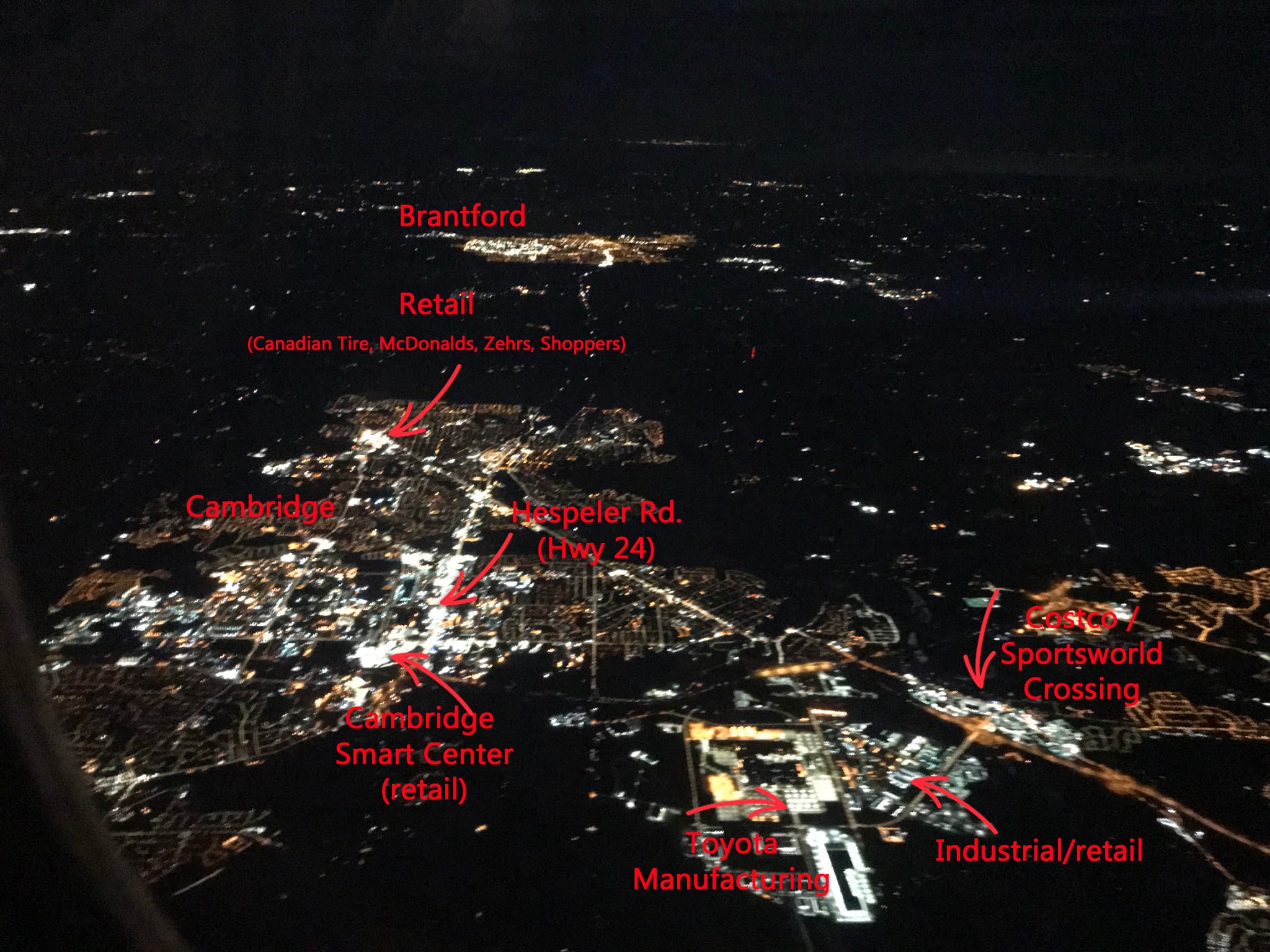No products in the cart.
This (annotated) photo shows Cambridge Ontario environmental light pollution from 7000 meters up. It was taken by Dr. Ron Brecher while on an in-bound flight to Pearson Airport in Toronto, passing over the Region of Waterloo. Click or tap for larger image.
The need for stricter guidelines for commercial developments and the use of artificial light at night , has gone largely unaddressed and without concern for decades. Lighting levels need to be reduced and the use of white light LED (4000K, 5000K) prohibited entirely.
With new lighting technology like LED (light emitting diode) and the increasing use of white light (full spectrum, daytime) it is time for municipalities to took a serious look at this growing environmental pollution problem. It’s time to review those decades old guidelines and make updates so we are not continuing to increase light pollution, use the wrong type of lights, over-lighting and causing further harm the environment. Old “best practices” in lighting almost always come with the implementation and use of bad lighting.
As with most technologies, there are good and bad types and good and bad ways of using them. Many cases of over-lighting are a direct result of misconceptions (false notions) or lack of understanding.
In the photo above we see a lot of “hot spots” of white lighting. These are primarily retail and industrial properties. We should not be seeing this light so pronounced from 7000 meters up in the sky. The use of improperly shielded lights that allow light to shoot up into the night sky along with over-lighting (to bright) causes light to be ground reflected back up into the sky – made worse during snow cover months.
In municipal decision making, lighting has generally been viewed as a technical issue. However, it is appropriate that it be treated primarily as an environmental issue – because lighting decisions can affect the quality of both the natural and the built environment.
The use of bad lighting (even LED can be bad!), over-lighting and leaving lights on all night is not only out of step with Canada’s national energy conservation and sustainability strategies but has been, and is continuing to be, shown to be harmful to our environment and people.
What can we do?
Everyone from planners to contractors to retailers selling lighting to the consumers buying and installing it can help protect our night environment with just a few simple tweaks.
- When switching to LED, make sure the diodes are full recessed up in the fixture. The emitting light source itself (bulb/diodes) should not be visible from the property line in any direction from 1.5 meters vertical. To put this in context, if a person of average height was standing at the property line, he or she should not be able to see the source of the light (bulb/diodes). The fixture should shield it from view, like a lamp shade or hood would, and direct all the light down to the ground.
- Avoid using 4000K and 5000K white light. This is the bad stuff. It’s known to increase light pollution and pollute our night environment. Use 3000K or less. 2700K warm white for LED is an excellent choice and more environmentally friendly.
- When installing your lighting consider where it’s shining. You don’t want it shining onto neighbours properties or in their window. Light should be contained within your property boundary. Just because you can’t see the glare or direct light, doesn’t mean your neighbour can’t. It may be a nuisance to them and unwanted. Aim your lights down and be a good neighbour.
- Don’t over-light. Avoid outdoor lighting with claims of super lumens, super bright. These are bad for the environment and actually are not safe contrary to what the marketing message may tell you. Over-lighting makes it more difficult to see, glare and intense light sources, limit our vision at night. Think of someone shining a flashlight in your eyes. Lights that are to bright make it more difficult to see into adjacent areas that may be darker and can lead to accidents or injury. Since light reflects of surfaces (which is why we can see things), its important to consider that lights that are to bright will cause higher levels of ground reflection of the light. This is light bouncing off the ground and back up into the sky. Snow cover makes this worse. Using outdoor lights that are to bright also may increase light trespass and your neighbours might not like that. Less light is better and that’s a proven scientific fact. You’re eyes are remarkable at adapting to low light levels and it will also prevent your vision from being overwhelmed (blinded) which leads to discomfort or disability glare problems for seeing at night.
- Turn your lights off over night. This is a simple one. Just like you were probably taught as a youngster to turn off the lights when you left a room in the home, the same can be done with outdoor lighting. There is no need to have it on all night when you are inside watching tv or sleeping. Leaving lights on over night does not make your safer. It does however put a spot light on your home because many of your neighbours or other home owners on your street probably turn their lights off. Leaving them on is like yelling hey look over here and see what I have! Turn those lights off.
- For businesses and over-night lighting, its not only good for our environment to turn off unnecessary lighting but also part of being a good neighbour in your community. Helping to protect our environment may already be part of your company’s green initiatives – turning off lights can be a benefit. It saves energy and helps to reduce climate change impacts. If lights are needed on consider only using what’s needed. Perhaps turn off every other light for a 50% reduction! Use timers so lights go off over night or when the business closes. Motion activated lights are useful when the lights don’t need to be all of the time. Don’t forget that lit signage – turn it off too. Many municipalities regulate over night lit signage and require it to be turned off when the business is closed or from 11pm to morning.
If we all do our part like putting litter in its proper place, we can all help to protect our night environment and our own health. Pollution doesn’t stop just because you are sleeping and don’t see it. It’s important to remember that in order for us to have a healthy daytime, we need to have a healthy nighttime.
Have a comment or question? Feel free to leave one below.
Clear skies!

My story began more than 40 years ago looking up at the Moon with a small telescope my Father had. Encouraged by my parents, who bought me my very own telescope, a 4.5″ reflector, I began to explore the night sky from my family home backyard. Today I do astrophotography from my home in Kitchener, Ontario and also with remote telescopes located in New Mexico and Australia. Some of my images have won awards and have been featured online and in magazines.



Leave a comment...